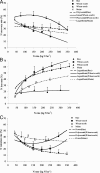Reducing environmental risk by improving N management in intensive Chinese agricultural systems
- PMID: 19223587
- PMCID: PMC2644255
- DOI: 10.1073/pnas.0813417106
Reducing environmental risk by improving N management in intensive Chinese agricultural systems
Erratum in
- Proc Natl Acad Sci U S A. 2009 May 12;106(19):8077
Abstract
Excessive N fertilization in intensive agricultural areas of China has resulted in serious environmental problems because of atmospheric, soil, and water enrichment with reactive N of agricultural origin. This study examines grain yields and N loss pathways using a synthetic approach in 2 of the most intensive double-cropping systems in China: waterlogged rice/upland wheat in the Taihu region of east China versus irrigated wheat/rainfed maize on the North China Plain. When compared with knowledge-based optimum N fertilization with 30-60% N savings, we found that current agricultural N practices with 550-600 kg of N per hectare fertilizer annually do not significantly increase crop yields but do lead to about 2 times larger N losses to the environment. The higher N loss rates and lower N retention rates indicate little utilization of residual N by the succeeding crop in rice/wheat systems in comparison with wheat/maize systems. Periodic waterlogging of upland systems caused large N losses by denitrification in the Taihu region. Calcareous soils and concentrated summer rainfall resulted in ammonia volatilization (19% for wheat and 24% for maize) and nitrate leaching being the main N loss pathways in wheat/maize systems. More than 2-fold increases in atmospheric deposition and irrigation water N reflect heavy air and water pollution and these have become important N sources to agricultural ecosystems. A better N balance can be achieved without sacrificing crop yields but significantly reducing environmental risk by adopting optimum N fertilization techniques, controlling the primary N loss pathways, and improving the performance of the agricultural Extension Service.
Conflict of interest statement
The authors declare no conflict of interest.
Figures
References
-
- Galloway JN, et al. Transformation of the nitrogen cycle: Recent trends, questions, and potential solutions. Science. 2008;320:889–892. - PubMed
-
- Galloway JN, et al. Nitrogen cycles: Past, present, and future. Biogeochemistry. 2004;70:153–226.
-
- Erisman JW, Bleeker A, Galloway JN, Sutton MS. Reduced nitrogen in ecology and the environment. Environ Pollut. 2007;150:140–149. - PubMed
-
- Editorial Committee of China Agricultural Yearbook. China Agricultural Yearbook 1980–2006 (in Chinese) Beijing: China Agricultural Press;
-
- Zhu ZL, Chen DL. Nitrogen fertilizer use in China - contributions to food production, impacts on the environment and best management Strategies. Nutr Cycl Agroecosyst. 2002;63:117–127.
Publication types
MeSH terms
Substances
LinkOut - more resources
Full Text Sources
Other Literature Sources


